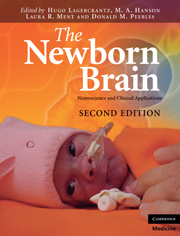Book contents
- Frontmatter
- Contents
- List of contributors
- Preface to the First Edition
- Preface to the Second Edition
- 1 Reflections on the origins of the human brain
- Section 1 Making of the brain
- Section 2 Sensory systems and behavior
- Section 3 Radiological and neurophysiological investigations
- 13 Imaging the neonatal brain
- 14 Electroencephalography and amplitude-integrated EEG
- 15 Emergence of spontaneous and evoked electroencephalographic activity in the human brain
- Section 4 Clinical aspects
- Section 5 Follow-up
- Section 6 Consciousness
- Index
- Plate section
- References
13 - Imaging the neonatal brain
from Section 3 - Radiological and neurophysiological investigations
Published online by Cambridge University Press: 01 March 2011
- Frontmatter
- Contents
- List of contributors
- Preface to the First Edition
- Preface to the Second Edition
- 1 Reflections on the origins of the human brain
- Section 1 Making of the brain
- Section 2 Sensory systems and behavior
- Section 3 Radiological and neurophysiological investigations
- 13 Imaging the neonatal brain
- 14 Electroencephalography and amplitude-integrated EEG
- 15 Emergence of spontaneous and evoked electroencephalographic activity in the human brain
- Section 4 Clinical aspects
- Section 5 Follow-up
- Section 6 Consciousness
- Index
- Plate section
- References
Summary
Introduction
Ultrasound is the routine imaging tool for assessing and monitoring the neonatal brain. It is cheap, mobile, and easy to use, and in experienced hands serial examination provides valuable information about the normal and abnormal brain. Computed tomography exposes the already sick neonate to unacceptable radiation and may miss clinically important pathology. Magnetic resonance imaging (MRI) has become an invaluable adjunct to ultrasound: the two techniques have complementary roles with ultrasound providing an ideal screening tool. MRI is safe and can therefore be used serially; in addition, unlike ultrasound, it may be used when the anterior fontanelle has closed. Unfortunately MRI of the sick or very preterm neonate is not easy and experience is limited to relatively few centers, both in the practicalities of performing a successful examination and in the interpretation of the results.
The increasing literature on advanced postacquisition analysis of MR images is evidence of the power of this tool to investigate the normal and abnormal developing brain but these techniques depend on high-quality imaging datasets, which may be difficult to acquire. The aim of any neonatal MR examination, whether performed for clinical or research studies, is to produce high-quality datasets, safely and in an acceptable acquisition time.
Practical issues
Sedation
Successful imaging of the neonatal brain requires careful preparation of the infant and close cooperation between radiologist, radiographer, and neonatologist. Neonates may be successfully imaged during natural sleep, following a feed, or under light sedation (Rutherford, 2002).
- Type
- Chapter
- Information
- The Newborn BrainNeuroscience and Clinical Applications, pp. 199 - 210Publisher: Cambridge University PressPrint publication year: 2010

